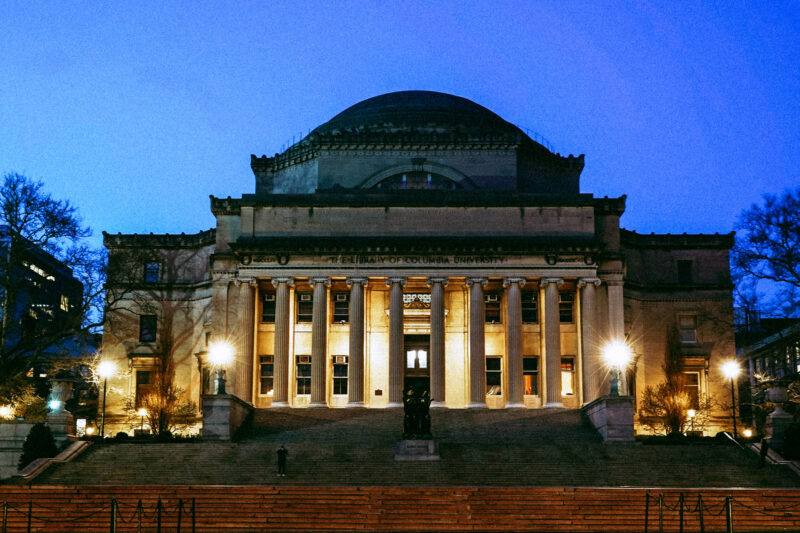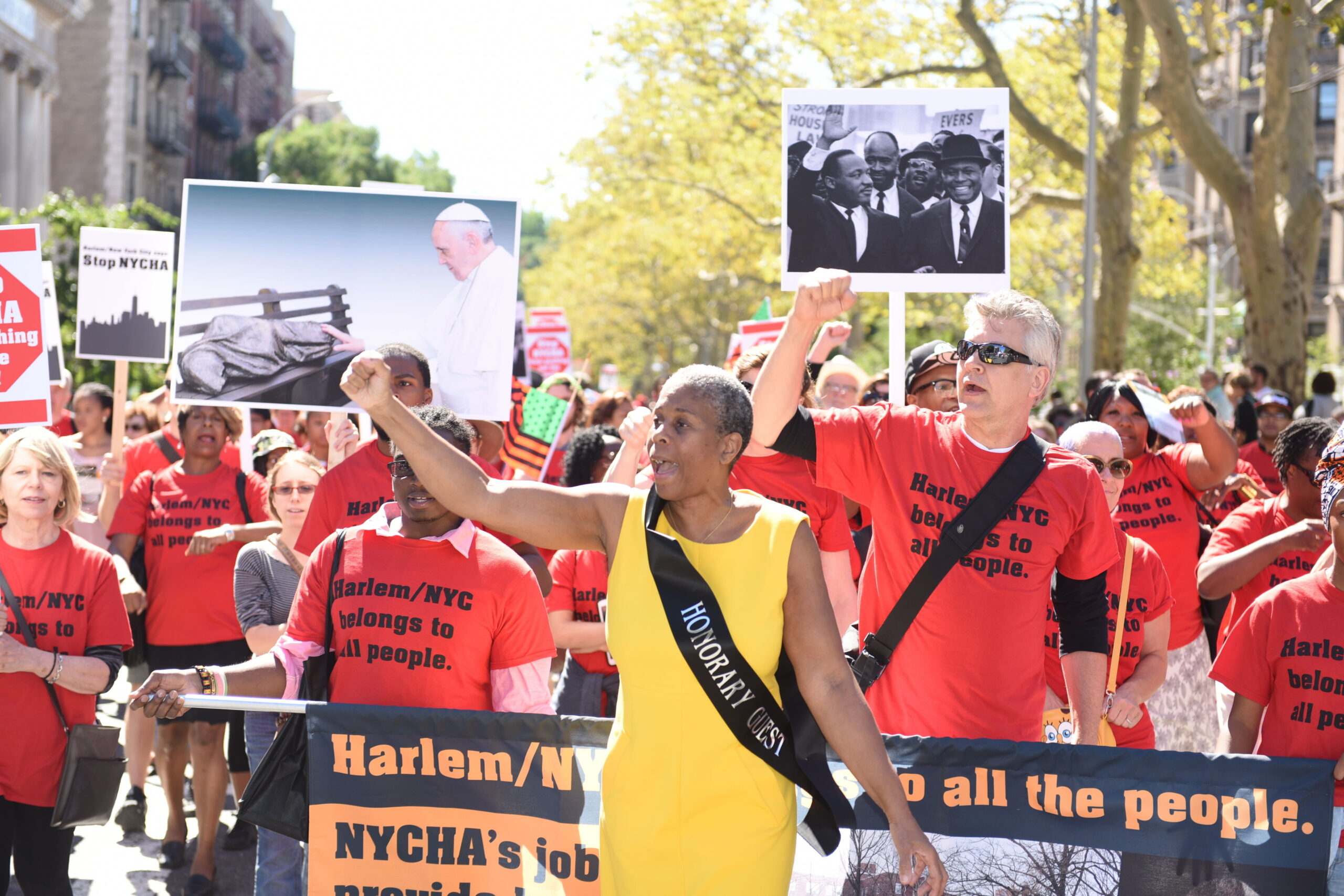How Columbia’s Gentrification Impacts Reproductive Justice in West Harlem
The gap in access to reproductive health care caused by the closing of St. Luke’s-Roosevelt Hospital has not yet been filled in West Harlem.

This story is part of our back to school issue. Check out the rest of our Campus Dispatch stories here.
In 1990, at a protest against the move of reproductive care units from St. Luke’s-Roosevelt Hospital in West Harlem to midtown New York that drew over 400 people, Harlem politician Charles Sutton said the hospital’s relocation would affect the quality of life for mothers and children in Harlem.
“In South Africa, children are born from womb to tomb,” Sutton, then the Democratic representative of Assembly District 70, told the Columbia Daily Spectator that March. “That, to me, sounds a lot like Harlem.”
In the 1980s and 1990s, residents and local health officials were concerned with Harlem’s high infant and maternal mortality rates. The loss of reproductive care at a local hospital felt like a critical hit, particularly in the context of the closure of seven hospitals in Harlem in the previous 15 years and the burgeoning AIDS epidemic. According to the Spectator article, 1 in 21 women who had babies and 1 in 61 infants in upper Manhattan tested HIV-positive during this time and needed more intensive medical treatment before, during, and after birth.
Though HIV-related mortality peaked in 1995, and infant and maternal mortality rates in Harlem have gone down since the 1990s, Harlem still faces a crisis in reproductive health. This includes West Harlem, the area that contains Columbia University.
Compared to wealthier neighborhoods in Manhattan, West Harlem residents—including pregnant women—experience less access to health care and poorer health outcomes than wealthier neighborhoods in Manhattan. New York City Health Department data shows that 26 percent of residents in West Harlem reported going without needed medical care in the past year, compared to 13 percent in Manhattan. Additionally, chronic conditions like hypertension, obesity, and diabetes appeared among West Harlem residents at higher rates than among Manhattan’s population as a whole.
At the 1990 rally, a Barnard College student told the Spectator she believed the university should get involved in addressing the community’s lack of access to reproductive care.
“Columbia has a lot of influence in this community, but instead they use it to build expensive apartments,” the Barnard student said. Several politicians, faith leaders, and community members echoed her sentiments.
Infant and maternal mortality rates remain high in West Harlem, according to local politicians, and West Harlem residents are over twice as likely to access little to no prenatal care during pregnancy than the average resident of New York City. While Columbia students have seen expanded access to reproductive health care, for the rest of the neighborhood, this access has remained a primary concern of West Harlem and city officials, particularly for pregnant people, leading to initiatives such as the Citywide Doula Initiative.
Yet even today, Columbia remains an uninvolved partner in the reproductive health crisis befalling its neighbors. As the Barnard student said in 1990, the University’s pursuit of building “expensive apartments,” rather than helping address the reproductive health crisis, might be exacerbating the crisis itself.
Columbia’s role in gentrifying Harlem

Originally called King’s College and established in 1754, the school was renamed Columbia University after the Revolutionary War. Its original campus was located in lower Manhattan on 50th street and Madison Avenue, but in 1896, then-University President Seth Low (who would go on to become the mayor of New York City) moved the campus to its current location in Morningside Heights as part of what one architect called Low’s desire to make Columbia “become a great urban university, in and of the city.”
At the time of the campus relocation, Morningside Heights was a predominantly white neighborhood. However, as the neighboring Harlem grew into a thriving Black and Puerto Rican community, the university began to “butt heads” with it and oppose Harlem’s development, according to a student researcher in the Columbia University & Slavery Seminar, an undergraduate seminar that investigates Columbia’s history and connections to slavery.
Columbia’s gentrification of Harlem, which students and community advocates say has accelerated since the late 2000s, has created unsustainable living conditions for many West Harlem residents. A June 2024 report found that between 2010 and 2020, the district lost 2,000 families, including 4,060 children. A majority of the people who left were Black (3,800 residents) and Hispanic (4,500 residents).
The report also noted that in Community Board 9 (CB 9)—the district encompassing West Harlem, which includes the communities of Morningside Heights and Hamilton Heights—rent-regulated private rental housing stock decreased from 65 percent in 2008 (22,500 units) to approximately 48 percent in 2022 (16,700 units)—a loss of almost 6,000 units. Additionally, data shows that over 1,000 residential and commercial evictions have occurred in CB 9 since 2017.
While eviction data does not directly correspond to homelessness, a report published in Housing Policy Debate found an association between an increase in eviction filings and an increase in homelessness in an area.
Despite the exodus of Black and Latino residents from West Harlem, the community still has a high number of residents in these demographics, and a New York City Health Department report found that “women who spent time in shelter while pregnant were more likely to be Black or Latina.” As Rewire News Group found in 2020, losing your housing is one of the greatest threats to your reproductive health.
According to Wendy Chavkin, former head of the New York City Department of Health’s reproductive health unit and a retired professor of obstetrics gynecology and public health at Columbia Medical Center, living at a city-provided shelter increases “the likelihood that you’re going to be exposed to infection, to environmental toxins or insults, to violence, to drugs, to lack of sleep because of the crowded, noisy circumstances.”
“Everything is just more difficult,” Chavkin said.
West Harlem’s reproductive landscape
In CB 9, maternal and infant health has been a rising concern in recent years, prompting action from local politicians.
According to New York City Health Department data, in Morningside Heights and Hamilton Heights, 10.9 percent of pregnant people receive late or no prenatal care, which is over twice as high as the rate of expecting individuals receiving late or no prenatal care in all of Manhattan (5.3 percent) and still significantly higher than the city’s overall rate.
The dataset also found that teenage expectancy rates in Morningside Heights hovered around 10.8 out of 1,000 girls aged 15 to 19—a rate higher than the Manhattan average (8.2 out of 1,000) and lower than the New York City average (13.2 out of 1,000). This same trend carries into infant mortality rates, which are higher in Morningside Heights and Hamilton Heights (3.5 out of 1,000) than the rest of Manhattan (2.7 out of 1,000) and lower than the NYC average (4.1 out of 1,000).
These numbers have concerned local health officials and politicians and led to the Health and Environment Committee of CB 9 unveiling a resolution in February to address high infant and maternal mortality rates within the district.
The high rate of expectant individuals not receiving adequate prenatal care may be the result of a lack of physical and/or financial access. Despite protests in 1990, St. Luke’s still moved its inpatient obstetric, pediatric, and neonatal units to its Midtown location. A group of Harlem residents brought a federal lawsuit against the hospital in 1992, alleging it had moved because many of its upper-Manhattan patients were poor and did not carry adequate insurance.
After a series of name changes, St. Luke’s eventually became known as Mount Sinai Morningside in 2020. Mount Sinai Morningside currently offers reproductive care services to West Harlem, including neonatal units and childbirth classes. However, according to U.S. News & World Report, Mount Sinai Morningside treats low-income and uninsured patients at significantly lower rates than other hospitals. Only 5.7 percent of patients the hospital treats are insured by Medicaid, and the hospital provides free and discounted care for uninsured patients that aligns with the proportion of uninsured community members at a lower rate than other hospitals.
The gap in access to reproductive health care caused by the closing of St. Luke’s-Roosevelt Hospital has not yet been filled in West Harlem. However, programs such as the Citywide Doula Initiative have attempted to bridge this divide and provide expectant individuals with medical care before their due dates.
Jacob Dubner, a co-chair of the student-run Columbia Student Medical Outreach clinic and fourth-year student at Columbia Medical Center, said that while insurance status could be a barrier to care for a majority of patients, patients who become pregnant in New York City are eligible to enroll in Medicaid for the duration of their pregnancy and up to one year after birth, regardless of their immigration status.
However, Chavkin said the process of obtaining Medicaid could be difficult, particularly for expectant individuals experiencing homelessness during their pregnancies.
“There’s still a lot of administrative, cumbersome stuff that has to be done,” Chavkin said. “That’s the kind of thing that is just more difficult when you have less control over your daily life.”
Gentrification’s effect on reproductive justice
“The question of gentrification is, of course, linked [to reproductive health] because it’s creating a landscape of inequity,” Lindsay Harkema, an architect and an educator at Barnard College, Columbia University, City College of New York, and other institutions, said.
Harkema also co-curated the Spatializing Reproductive Justice exhibit, which opened in April. The exhibit encourages architects, health professionals, and others to think about ways that public design can facilitate reproductive justice.
Though Harkema said the exhibit did not explicitly engage with gentrification as an obstacle to reproductive justice, she found the connection undeniable.
“Reproductive justice is the right to bodily autonomy,” Harkema said. “It’s the right to have children, to not have children, and to raise families in safe and sustainable communities.”
Harkema also believes that public design can help facilitate reproductive justice, such as creating public housing in areas that can provide access through proximity to reproductive health care, or by including aspects of reproductive health care (such as abortion pills) within the housing location itself.
Financial stress caused by exorbitant rent prices can also cause negative outcomes during and after pregnancy. One report found that over 50 percent of households in West Harlem were rent-burdened from 2017 to 2021, meaning they spent over 30 percent of their income on rent.
“Once your prices go up past 30 [to] 4o percent towards rent, then you have less and less money to take care of your actual day-to-day health and bills that come with that, as well as family,” Kai Cogsville, founder of Defend Harlem, a group within the New York Interfaith Commission for Housing Equality, said.
Exorbitant rent fees leave expectant individuals and families with children with less money to pay for food or basic necessities, which can affect their health and lead to less desirable infant and maternal health outcomes during birth.
“There are all sorts of poverty-associated risks during pregnancy,” Chavkin said. For example, she noted, “You’re more likely to need to go to the doctor more often.” Though Medicaid may cover the costs of the visit, leaving work and traveling can pose financial and physical strains on individuals experiencing pregnancy regardless.
As West Harlem politicians attempt to bolster West Harlem’s reproductive health, Columbia’s students have celebrated several on-campus reproductive justice victories. In March, the university began providing on-campus abortion services to students in addition to contraceptives.
New York universities, both public and private, have taken steps to support the reproductive health care and well-being of their students, Harkema said. She called Columbia and other college campuses offering reproductive health care to students a “kind of sanctuary”—a stark contrast to the state of reproductive health in West Harlem.
However, Harkema remains optimistic that the reproductive health-care models implemented by colleges can be extended outward.
How can Columbia get involved?

Community members have urged students and the university to get involved in addressing the reproductive health-care crisis for years in West Harlem. In a Spectator editorial titled “Natal Neglect,” published a couple of days before the 1990 rally protesting the loss of natal units at St. Luke’s, the editorial board urged students to get involved in addressing the reproductive health crisis in Harlem.
“Students should take this opportunity to become involved in community projects through St. Luke’s that benefit neighborhood babies and their mothers, though such volunteers are always needed,” the editorial said. “Through such action, students can climb down from the ivory tower and demonstrate a sense of altruism that many contend is lacking.”
Today, ways for students to get involved in bolstering the reproductive health of West Harlem seem to have disappeared along with the natal units of St. Luke’s-Roosevelt Hospital. Calls for the university to help support the community’s reproductive health care, which reached their peak during the AIDS epidemic, have largely disappeared too.
However, students have a long history of advocating with their neighbors against Columbia’s gentrification and trying to address the general health-care crisis in upper Manhattan through advocacy and student-run clinics.
“I think if you’re genuinely looking to learn from your time at Columbia, you can’t really separate what goes on in the classroom from what is happening, you know, ten blocks uptown,” Hagan Feney, a coordinator with the Housing Equity Project, a Columbia student organization, said.
The Housing Equity Project works to improve the lives of unhoused community members around Columbia by providing them with food and ensuring the continued operation of two homeless shelters through volunteer staffing. In his role with the Housing Equity Project, Feney works with Defend Harlem to research how Columbia has affected West Harlem through gentrification.
Columbia Student Medical Outreach is one of several clinics run by student physicians at the Columbia University Vagelos College of Physicians and Surgeons. According to Duber, Columbia Student Medical Outreach provides direct care services to up to 30 residents a month in Washington Heights. Other student clinics provide health-care services to residents of West Harlem.
Bryony Roberts, a professor at the Columbia Graduate School of Architecture, Planning, and Preservation and co-curator of the Spatializing Reproductive Justice exhibit alongside Harkema, said it would be “difficult” for the university to provide direct reproductive health care to community members in the way it does for students.
“But I think that there’s a lot of ways that the university can invest in all of the other infrastructural and environmental aspects of reproductive justice,” Roberts said. To Roberts, that begins with listening to the needs of community groups and members and collaborating with them in “creating healthy environments, reducing pollution, increasing access to healthy food, … [and] good, safe transportation.”
Harkema expressed a slightly different view.
“Now, unfortunately, our public institutions and funding networks are totally stripped down such that we can’t do everything without private support,” Harkema said. “That’s true in education. That’s true in the public space.”
And, Harkema added, “it’s always kind of been true in reproductive health care as well.”
“Certainly everyone benefits when everyone has access to the resources and the care that they need,” Harkema continued. “So it really doesn’t make sense to prioritize the needs of one population … that’s associated with the private institution and not everyone else in the immediate proximity.”

